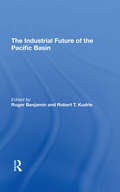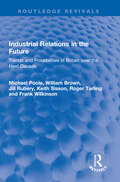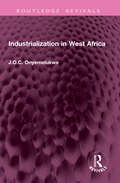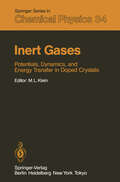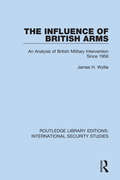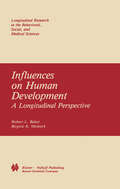- Table View
- List View
India Under Pressure: Prospects For Political Stability
by Robert L. HardgraveIndia, as the dominant power in South Asia, is the region’s keystone for stability. Contending that the Indian government is under ever-increasing pressure as a result of internal social and political conflict, Dr. Hardgrave provides a broad survey of the sources of conflict: regionalism, particularly demands for separation and autonomy in Assam and the Punjab; enmity between religious groups, manifested in increased Hindu-Muslim tensions; caste violence; peasant unrest in the countryside; and protests among students and labor groups in the cities. The author analyzes the capacity of India’s political parties, the bureaucracy, and the military to cope with change and to manage the country’s social diversity and the potential for conflict. In particular, he examines the ruling Congress party, the leadership style of Prime Minister Indira Gandhi, the problem of succession, prospects for unity among opposition parties, and the potential impact of a coalition government on political stability. In considering the role that foreign relations play in India’s political stability, Dr. Hardgrave discusses India’s relations with South Asia, the Middle East, the Soviet Union, China, and the United States.
India Under Pressure: Prospects For Political Stability
by Robert L. HardgraveIndia, as the dominant power in South Asia, is the region’s keystone for stability. Contending that the Indian government is under ever-increasing pressure as a result of internal social and political conflict, Dr. Hardgrave provides a broad survey of the sources of conflict: regionalism, particularly demands for separation and autonomy in Assam and the Punjab; enmity between religious groups, manifested in increased Hindu-Muslim tensions; caste violence; peasant unrest in the countryside; and protests among students and labor groups in the cities. The author analyzes the capacity of India’s political parties, the bureaucracy, and the military to cope with change and to manage the country’s social diversity and the potential for conflict. In particular, he examines the ruling Congress party, the leadership style of Prime Minister Indira Gandhi, the problem of succession, prospects for unity among opposition parties, and the potential impact of a coalition government on political stability. In considering the role that foreign relations play in India’s political stability, Dr. Hardgrave discusses India’s relations with South Asia, the Middle East, the Soviet Union, China, and the United States.
Individual Susceptibility to Genotoxic Agents in the Human Population (Environmental Science Research #30)
by Frederick J. De Serres Ronald W. Pero William SheridanAs a result of the industrial revolution, man's technological achievements have been truly great, increasing the quality of life to almost unimagined proportions; but all this progress has not been accomplished without equally un imagined health risks. Sufficiently diagnostic short-term assay procedures have been developed in recent years for us to determine that there are mutagenic agents among thou sands of chemicals to which the human population is exposed today. These chemicals were not significantly present prior to the indus trial revolution. As of today, there are no procedures available which have been adequately demonstrated to assess individual sus ceptibility to genotoxic exposures, and as a result we have had to rely on extrapolating toxicological data from animal model systems. The question is can we afford to allow such an increased environ mental selection pressure via mutagenic exposures to occur without expecting adverse long-term effects on our health. It is apparent from this line of reasoning that what is lacking and immediately needed are test procedures that can be applied to humans to assess genotoxic exposure as well as individual susceptibility to it. There have already been two conferences which have focused at tention on this research area. "Guidelines for studies of human populations exposed to mutagenic and reproductive hazards" (A. D. Bloom, ed., March of Dimes Birth Defects Foundation, White Plains, New York, 1981) and "Indicators of genotoxic exposure in humans" (Banbury Report 13, B. A. Bridges, B. E. Butterworth, and I. B.
The Individual Vs. The Public Interest: Political Ideology And National Forest Policy
by Richard M. AlstonCentral to the controversy surrounding U. S. natural resources policy is the conflict between environmentalists and proponents of development. Examining the evolution of the philosophies underlying that conflict, Dr. Alston traces the failure to achieve a unified resources policy to the seemingly incompatible ideological positions held by resource specialists, interest groups, policymakers, econo mists, and foresters. His analysis goes beyond his case study of na ional forest policy to focus on an ancient question basic to policy making in a democratic society: How can government provide a sociopolitical framework that accomodates both individual interests and the need for unity in a collective existence? Only within this broader framework, he argues, is it possible to determine the proper division between private and public resource management or the proper role of government in natural resources planning. Incorporating a critical evaluation of the development of classical and neoclassical economic theory, this work makes clear the need to strike a balance between a strictly individualistic and an ecological point of view. Dr. Alston illustrates the ideological conflicts that complicate resources planning and explores the possibility of a new ideology capable of accomodating and inte grating differences to meet the complex needs of society.
The Individual Vs. The Public Interest: Political Ideology And National Forest Policy
by Richard M. AlstonCentral to the controversy surrounding U. S. natural resources policy is the conflict between environmentalists and proponents of development. Examining the evolution of the philosophies underlying that conflict, Dr. Alston traces the failure to achieve a unified resources policy to the seemingly incompatible ideological positions held by resource specialists, interest groups, policymakers, econo mists, and foresters. His analysis goes beyond his case study of na ional forest policy to focus on an ancient question basic to policy making in a democratic society: How can government provide a sociopolitical framework that accomodates both individual interests and the need for unity in a collective existence? Only within this broader framework, he argues, is it possible to determine the proper division between private and public resource management or the proper role of government in natural resources planning. Incorporating a critical evaluation of the development of classical and neoclassical economic theory, this work makes clear the need to strike a balance between a strictly individualistic and an ecological point of view. Dr. Alston illustrates the ideological conflicts that complicate resources planning and explores the possibility of a new ideology capable of accomodating and inte grating differences to meet the complex needs of society.
Individuality and Determinism: Chemical and Biological Bases
by Sidney FoxThe significance of human individuality is such that each human functions as a unique "molecular" unit of the mass of humanity. Understanding the natural basis for the uniqueness of the individual has long been an objective. The possibilities have been analyzed by Julian Huxley, by A. E. Needham, by Roger Williams, and by others. With his books Biochemical Individuality and Free and Unequal, Roger Williams has done as much as anyone to focus atten tion on this complex of questions. Although scheduled to partici pate in this program, Roger Williams* was unable to attend due to illness. He asked, however, that a quotation be included in the proceedings. This quotation from Chraka is presented early in this book. While metabolic bases for individuality have received a con siderable investigation and discussion by Williams and others, the case for underlying determinants and derivative consequences have not been examined as fully. The specificities that abound in our living world can be traced to the manner in which molecules fit with each other. While numerous studies having other objectives can be cited in support of molecularly based specificities, a few of the leaders in the development of the understanding of physical aspects of biological information present here some of their latest inferences. Several of the participants discuss some of the conse quences at higher levels. Examination of the fascinating cases of reunited identical twins are seen as providing a capstone to the hierarchical treatment.
Industrial Electrochemistry
by Derek PletcherElectrochemistry is clearly an important component of the technology of many quite diverseindustries. Moreover, the future for electrochemical technology is bright and there is a general expectation that new applications of electrochemistry will become economic as the world responds to the challenge of more expensive energy, of the need to develop new materials and to exploit different chemical feedstocks and of the necessity to protect the environment. " Inthis situation, the present rather fragmentary state ofelectrochemical technology is disappointing. Whilethere are many similarities in the underlying principles and even the practices of the electrochemically based industries, they are often not fully appreciated. Certainly, the Rand D programmes in many industries are in the hands of those with little formal training and whose experience of and interest in other branches of electrochemistry is very limited. Moreover, the academic world has done little to help. Electrode processes are, too often, totally ignored in courses to both scientists and engineers and certainly electrochemical technology is almost never taught as a unified subject with an appropriate balance between fundamentals, engineering and applications. Overall, it isnot surprising that the various strands have not interwoven and that scientists and engineers do not have a proper appreciation of the importance of electrochemical technology. Inthe first half of 1979 I conducted a survey into the research and development needs of the various industries in Britain using electrochemical technology.
The Industrial Future Of The Pacific Basin
by Roger Benjamin Robert T KudrleThe consequences of changing comparative advantage are transforming the economic landscapes of nations and regions around the globe. This book deals with the most significant economic factors in the rapidly changing Pacific Basin area. Part 1 considers the area’s changing patterns of industrial development and trade and examines the general implications of such changes for national industrial development policies. Part 2 consists of a set of case studies of national industrial policies in the context of factors affecting industrial structures; how applicable these policies are to other countries in the region is a central theme. Part 3 addresses the specific issues of foreign investment and domestic labor in relation to economic growth and industrial development in the Pacific Basin. Finally, in Part 4 institutional arrangements are suggested that would facilitate economic growth while, at the same time, mitigating the serious negative consequences of changing economic advantage. Such negative consequences are to some extent pervasive and can destabilize social and political development and endanger formal and informal alliances; nevertheless, the segment of humanity that has adequate food, clothing, and shelter is being permanently widened in the Pacific Basin.
The Industrial Future Of The Pacific Basin
by Roger Benjamin Robert T KudrleThe consequences of changing comparative advantage are transforming the economic landscapes of nations and regions around the globe. This book deals with the most significant economic factors in the rapidly changing Pacific Basin area. Part 1 considers the area’s changing patterns of industrial development and trade and examines the general implications of such changes for national industrial development policies. Part 2 consists of a set of case studies of national industrial policies in the context of factors affecting industrial structures; how applicable these policies are to other countries in the region is a central theme. Part 3 addresses the specific issues of foreign investment and domestic labor in relation to economic growth and industrial development in the Pacific Basin. Finally, in Part 4 institutional arrangements are suggested that would facilitate economic growth while, at the same time, mitigating the serious negative consequences of changing economic advantage. Such negative consequences are to some extent pervasive and can destabilize social and political development and endanger formal and informal alliances; nevertheless, the segment of humanity that has adequate food, clothing, and shelter is being permanently widened in the Pacific Basin.
Industrial Relations in the Future: Trends and Possibilities in Britain over the Next Decade (Routledge Revivals)
by Michael Poole William Brown Jill Rubery Keith Sisson Roger Tarling Frank WilkinsonFirst published in 1984, Industrial Relations in the Future highlights probable developments in Britain’s system of industrial relations into the 1990s. It also provides a basis for further and detailed analysis and debate of issues central to the nation’s future. Written by distinguished scholars in their respective fields, the three main sections give reviews from three contrasting traditions- mainstream industrial relations, industrial sociology and management, and labour economics. These accounts are highly complementary in the ways in which, in each and every case, issues of collective bargaining, managerial strategy and union response, and the behaviour of governments are all set against a broad backcloth of economic, political, and social changes. The authors see the ultimate outcome as depending greatly on the policies and types of action of organised labour, managements and governments, and possibly of wider social movements as well. This book will be an essential read for scholars and researchers of labour economics, industrial sociology, economics, and public policy.
Industrial Relations in the Future: Trends and Possibilities in Britain over the Next Decade (Routledge Revivals)
by Michael Poole William Brown Jill Rubery Keith Sisson Roger Tarling Frank WilkinsonFirst published in 1984, Industrial Relations in the Future highlights probable developments in Britain’s system of industrial relations into the 1990s. It also provides a basis for further and detailed analysis and debate of issues central to the nation’s future. Written by distinguished scholars in their respective fields, the three main sections give reviews from three contrasting traditions- mainstream industrial relations, industrial sociology and management, and labour economics. These accounts are highly complementary in the ways in which, in each and every case, issues of collective bargaining, managerial strategy and union response, and the behaviour of governments are all set against a broad backcloth of economic, political, and social changes. The authors see the ultimate outcome as depending greatly on the policies and types of action of organised labour, managements and governments, and possibly of wider social movements as well. This book will be an essential read for scholars and researchers of labour economics, industrial sociology, economics, and public policy.
Industrial Robot Specifications
by Adrian IoannouThe industrial application of robots is growing steadily. This is reflected in the number of manufacturers now in volved in the field of robotics. Thanks to pioneers such as Joseph Engelberger of Unimation Inc, industry has seen their rapid deployment in all areas of manufacturing. Manufacturers of robots and robotic equipment have increased their production levels and at the same time have made great efforts to improve and adapt their pro ducts to allow them to be used for a wider range of appli cations. The demand for ever more sophisticated robotic devices has made the choice of robot for a particular application an extremely hard one. Industrial Robot Specifications has been compiled to enable users to assess robotics in the context of their own needs. The book contains detailed information on over 300 robots manufactured and distributed under licence throughout Europe. More than 90 companies are cov ered, and details are given of their distributors and agents, regional addresses and names of key contacts. Information is provided on robots as diverse as simple teaching machines, costing perhaps £1500, to those highly sophisticated computer-controlled robot devices commonly found in flexible manufacturing systems, costing tens of thousands of pounds each. Introduction Industrial Robot Specifications is divided into three sec adjustable mechanisms that command manipulation.
Industrialization in West Africa (Routledge Revivals)
by J O OnyemelukweFirst published in 1984, Industrialization in West Africa is an authoritative text on the industrial development efforts, spatial characteristics and related problems of countries comprising the West African region. The book commences with a detailed description of the political and economic background against which the slow and unsteady pace of industrialization in each country can be appreciated. The analysis outlines the resource potential and historical evolution and structural characteristics of modern manufacturing in the region. The final section assesses the spatial characteristics of West African industrialization, the major problems inhibiting industrial development and frustrating efforts towards economic independence by each country. In conclusion the author considers remedial policy options open to West African countries, both individually and in a common market framework. This book is a valuable source material for all students of social science, geography, economics and regional planning.
Industrialization in West Africa (Routledge Revivals)
by J O OnyemelukweFirst published in 1984, Industrialization in West Africa is an authoritative text on the industrial development efforts, spatial characteristics and related problems of countries comprising the West African region. The book commences with a detailed description of the political and economic background against which the slow and unsteady pace of industrialization in each country can be appreciated. The analysis outlines the resource potential and historical evolution and structural characteristics of modern manufacturing in the region. The final section assesses the spatial characteristics of West African industrialization, the major problems inhibiting industrial development and frustrating efforts towards economic independence by each country. In conclusion the author considers remedial policy options open to West African countries, both individually and in a common market framework. This book is a valuable source material for all students of social science, geography, economics and regional planning.
Inert Gases: Potentials, Dynamics, and Energy Transfer in Doped Crystals (Springer Series in Chemical Physics #34)
by R. A. Aziz S. S. Cohen H. Dubost M. L. KleinResearch involving the chemical physics of the inert or rare gases continues unabated. This small volume is meant to deal with advances that have occurred in three selected areas over the past decade. It forms a natural outgrowth of earlier reviews and volumes that have dealt almost exclusively with pure rare-gas solids. Originally, a single chapter was envisaged to cover the topic of alloys and impurities in solid rare gases. However, over the past ten years this single chapter spawned many offshoots and eventually the project became too large for a single volume. Thus the present book contains only a small subset of possbile topics involving rare-gas solids intentionally doped with impurities. Chapter 1 gives a brief overview of current research devoted to the rare gases. This is followed by a comprehensive, self-contained chapter dealing with the most recent developments in the area of interatomic inter actions. Chapter 3 is concerned with the lattice dynamics of rare-gas solids doped with an impurity which is either another rare-gas or a small molecule. The final chapter deals with the spectroscopy of vibrating and rotating di atomic impurities in rare-gas solids. The birth of this volume was not without its labour pains. I should like to take this opportunity to thank the various people who have at one time or another been involved throughout its gestation period. Clearly, many important topics are omitted from this volume.
Infant Memory: Its Relation to Normal and Pathological Memory in Humans and Other Animals (Advances in the Study of Communication and Affect #9)
by MorrisMoscovitchThe study of infant memory has flourished in the past decade for a number of reasons, not the least of which is the tremendous growth of interest in normal and pathological adult memory that began in the late fifties. Despite its common lineage to other areas of memory research, however, infant memory has perhaps been the least integrated into the mainstream. In reading the literature, one gets a sense of discontinuity between the study of infant memory and memory at all other stages of development from childhood to old age. The reasons for this are not hard to find. The techniques used to study memory in infants are usually very different from those typically used even in children. These techniques often limit the kind of inferences one can draw about the nature of the memory systems under investigation. Even when terms, concepts, and theories from the adult literature are applied to infants, they often bear only a loose relationship to their original usage. For example, an infant who stares longer at a new pattern than an old one is said to "recognize" the old one and to have a memory system that shares many characteristics with a memory system that makes recognition possible in adults. Simi larly, an infant who emits a previously learned response, such as a leg kick, to an old stimulus is said to "recall" that response and to be engaged in processes similar to those of adults who are recalling past events.
Infectious Diseases of the Central Nervous System (Neurologic Illness)
by John R. Green Richard A. ThompsonThe contents of this volume are based upon the proceedings of a Sympo sium entitled "Infectious Diseases of the Central Nervous System" held in Phoenix, Arizona, and sponsored by the Barrow Neurological Institute and Foundation during its Ninth Annual Symposium. The purpose of the Symposium was to bring together knowledgeable experts in this field to review information that is available and to enhance our knowledge of new developments in the field of infectious diseases in the central nervous system. Because the subject could not be covered in its entirety by this volume, we have placed particular emphasis on recent developments and new information. The volume includes a remarkably fresh and interesting discussion of viral diseases as they affect the nervous system, including conventional and unconventional virus agents, and in addition, discussions of path ophysiology and epidemiology and postinfectious diseases of the nervous system. A similar approach is taken to the treatment of bacterial infection. Discussions of pathophysiology are intertwined with discussions of diag nostic techniques, prevention techniques and treatment of bacterial in fections. Additional surgical problems are discussed regarding prevention and management of peri operative infection and brain abscess. Special consid eration was given to coccidioidomycosis which is prevalent in the western states; also, there is a discussion of parasitic infections. This volume will be of interest to neurologists and neurosurgeons and any physician dealing with infectious disease. RICHARD A. THOMPSON, M.D. JOHN R. GREEN, M.D.
Infertility: Diagnosis and Management (Clinical Perspectives in Obstetrics and Gynecology)
by James AimanThe authors of this book have a goal-to describe the management of infertility from the perspective of physiology and anatomy gone awry. To accomplish this goal, the chapters devoted to the causes of infertil ity begin with a description of the normal structure and function of the organ or system causing the infertility. We believe that under standing the normal will result in rational and effective diagnosis and treatment of infertility. Our intent is that this book be a useful re source for those who care for infertile couples. For an infertile couple, success is the delivery of a normal and healthy infant. Chapters that describe the causes and treatment of habitual abortion and the reproductive performance of previously infertile couples emphasize the hazards that exist between conception and birth. Our environment is one of these hazards, one that may also affect reproduction before conception. A chapter is devoted to a de scription of environmental agents that affect reproduction, the mech anisms of their effect, and methods to predict those present and future environmental agents which might also affect reproduction.
Infinite-Dimensional Systems: Proceedings of the Conference on Operator Semigroups and Applications held in Retzhof (Styria), Austria, June 5-11, 1983 (Lecture Notes in Mathematics #1076)
by F. Kappel W. SchappacherThe Influence of British Arms: An Analysis of British Military Intervention Since 1956 (Routledge Library Editions: International Security Studies #10)
by James H. WyllieWhich event better characterises British military interventions: the trauma of Suez or the triumph of the Falklands? This book, first published in 1984, examines these engagements and those of the intervening period to provide a sober and considered response to this question. The issues raised are central to the debate concerning Britain’s defence capabilities and its role in world politics. The author argues that it is only under severely restricted conditions that Britain could reasonably expect a successful outcome from long-range military intervention. The constraints are not merely those of military capacity: public opinion also has its role to play. By analysing these conditions and the way they have influenced the outcomes of past interventions the author points the way to framing a practical and reasonable defence and foreign policy in the Third World.
The Influence of British Arms: An Analysis of British Military Intervention Since 1956 (Routledge Library Editions: International Security Studies #10)
by James H. WyllieWhich event better characterises British military interventions: the trauma of Suez or the triumph of the Falklands? This book, first published in 1984, examines these engagements and those of the intervening period to provide a sober and considered response to this question. The issues raised are central to the debate concerning Britain’s defence capabilities and its role in world politics. The author argues that it is only under severely restricted conditions that Britain could reasonably expect a successful outcome from long-range military intervention. The constraints are not merely those of military capacity: public opinion also has its role to play. By analysing these conditions and the way they have influenced the outcomes of past interventions the author points the way to framing a practical and reasonable defence and foreign policy in the Third World.
Influences on Human Development: A Longitudinal Perspective (Longitudinal Research in the Behavioral, Social and Medical Studies #4)
by R.L. Baker B.R. Mednick University of CaliforniaThis book is the product of the efforts of a number of people dating back to 1956, when Professor T. Kemp, then head of the University Institute for Human Genetics in Copenhagen, proposed a study on the importance of x-ray irradiation in pregnant women. Under the guidance of Professors Dyhre Trolle and Preben Plum of the Uni versity Hospital in Copenhagen, the investigation was expanded to deal with prenatal and perinatal factors of importance for the development of the infant. The corpus of medical data that resulted from these efforts was collected and organized by Drs. Bengt Zachau-Christiansen and Aage Villumsen. The project's birth cohort included all deliveries that took place at the State University Hospital, Rigshospitalet, Copenhagen, over a two-year period from 1959 to 1961. As part of the perinatal study, the mothers and children were subjected to regular and thorough medical examinations during pregnancy and through the first year of the child's life. The detailed data from these examinations, as well as information about treatment administered, were systematically collected and coded.






